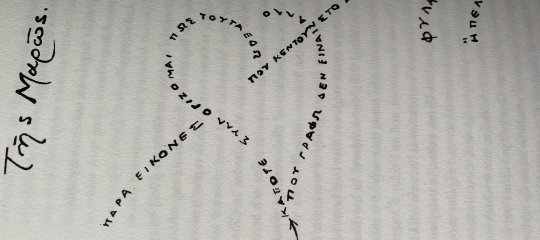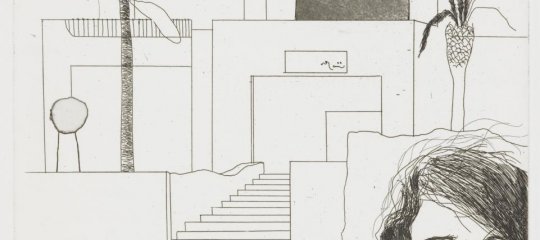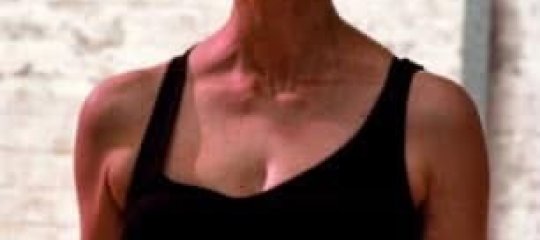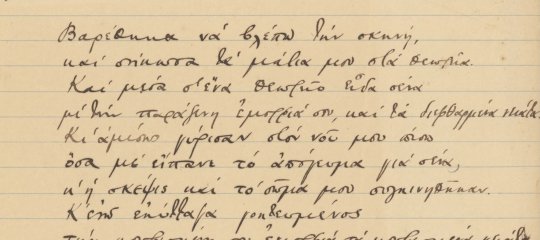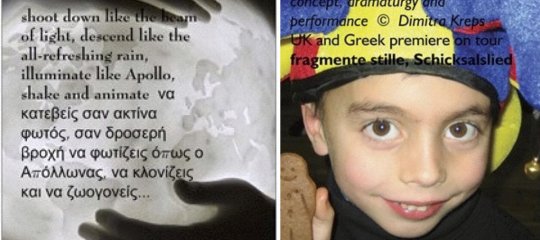Ξενάγηση στην Έκθεση 80 Ελλήνων καλλιτεχνών
Φλώρα Μόλχο
...όλα αυτά στο Κρατικό Μουσείο Σύγχρονης Τέχνης, στη Μονή Λαζαριστών, στη Θεσσαλονίκη
17 Ιανουαρίου 2007

Το ότι βρίσκομαι στη Θεσσαλονίκη δεν είναι τυχαίο. Ας πούμε ότι είναι τυχαίο το ότι γνώρισα τη Δήμητρα Μήττα που είχε διοργανώσει για την Κυριακή 13 Ιανουαρίου μια ξενάγηση για τους μαθητές της τής Δραματικής Σχολής, στο Κέντρο Σύγχρονης Τέχνης, στη Μονή Λαζαριστών. Με κάλεσε, πήγα.
Οφείλω να ομολογήσω ότι για μένα που δεν είμαι ειδήμων της εικαστικής τέχνης, η ξενάγηση αυτή υπήρξε μια μεγάλη αποκάλυψη. Όχι μόνο για τον χώρο, τα άγνωστα σε μένα έργα και την εξαιρετική διαρρύθμιση της έκθεσης αλλά και για το κλίμα που δημιουργήθηκε και έκανε την περιπλάνηση αυτή μέσα στην τέχνη, κάτι το μοναδικό και ανεπανάληπτο.
Η ξεναγός μας ήταν η λεπτεπίλεπτη και γλυκιά Εύα Παπαβέργου που με τις εξειδικευμένες γνώσεις της, έριχνε φως στο κάθε έργο.
Από τη μεριά της, η Δήμητρα Μήττα ζωντάνευε διαρκώς με τις παρεμβάσεις της και τις προτροπές της την περιπλάνηση στο χώρο, κι ας τολμούσες να αποξενωθείς έστω και για λίγο! Δεν σου άφηνε το περιθώριο! Ήθελες δεν ήθελες, σε ταρακουνούσε συνεχώς. Tυχερά τα παιδιά που την έχουν δασκάλα! Αυτά τα παιδιά που με τον ενθουσιασμό της νεαρής τους ηλικίας, τις παρατηρήσεις και απορίες τους, ζωντάνευαν ακόμα περισσότερο αυτό το ταξίδι στην τέχνη.

Αλλά ο από μηχανής Θεός ήταν η ξαφνική παρουσία ενός από τους καλλιτέχνες που είναι και ηθοποιός του θεάτρου, του Α. Παπαδημητρίου. Με τακτ, με εξαιρετική λεπτότητα και ευαισθησία, χωρίς να σʼαφήσει να το καταλάβεις (αυτό το κατάλαβα αργότερα), μπήκε κι αυτός στον ρόλο του ξεναγού, έναν ρόλο που δεν ήταν δικός του, ίσως όπως κάνει στο θέατρο και "έκλεψε κατά κάποιον τρόπο την παράσταση". Είναι κάπως σαν να λες: αυτή η πόρτα ήταν κλειστή, πώς μπήκε μέσα και δεν τον κατάλαβα; Και όχι μόνο πώς μπήκε μέσα αλλά και πώς όλοι μας το θεωρήσαμε τόσο φυσικό; Η τέχνη του καλού ηθοποιού; Οι γνώσεις του καλλιτέχνη; Η μαγεία και η γοητεία ενός ταχυδακτυλουργού; Ίσως όλα μαζί.
Μας εξήγησε πολλά και μάθαμε πολλά για την τέχνη και για τα έργα της έκθεσης και τους δημιουργούς τους. Μέσα από την πληροφόρηση πέρασαν και αποφθεγματικές φράσεις και αναφορές, κομμένες και ραμμένες στην περίπτωσή μας. Αναφέροντας την φράση του Όσκαρ Ουάιλντ "Όλοι οι άνθρωποι είναι καλοί ηθοποιοί εκτός από μερικούς ηθοποιούς", μάς το μετέφερε στην τέχνη, οπότε "Όλοι οι άνθρωποι είναι καλοί καλλιτέχνες εκτός από μερικούς καλλιτέχνες". Ας αναφέρω διάσπαρτα λίγα από τα όσα μας είπε: "Για να μπεις στην τέχνη χρειάζεται ένα απλό βηματάκι", "Η ίδια η ζωή είναι τέχνη", αλλά και " Το όμορφο μπορεί να είναι το δέλαρ της εξουσίας για να μας εξαπατήσει".
Eυχαριστώ πολύ τη Δήμητρα Μήττα που μου έδωσε την ευκαιρία όχι μόνο να δω την έκθεση αλλά και να παραβρεθώ σε ένα τόσο ευχάριστο πρωινό, όπως τελικά διαμορφώθηκε.
- Εισέλθετε στο σύστημα για να υποβάλετε σχόλια

